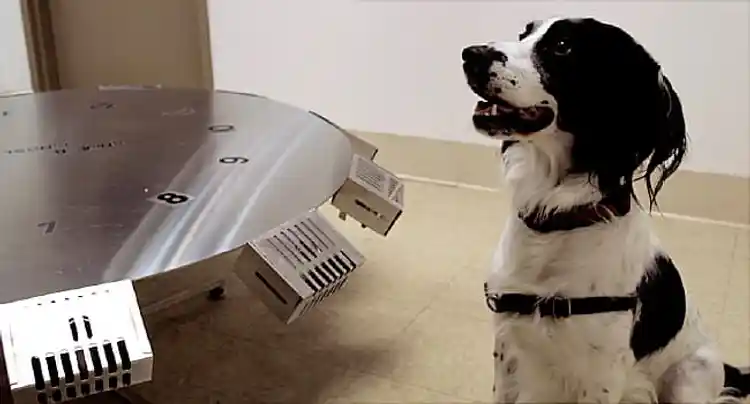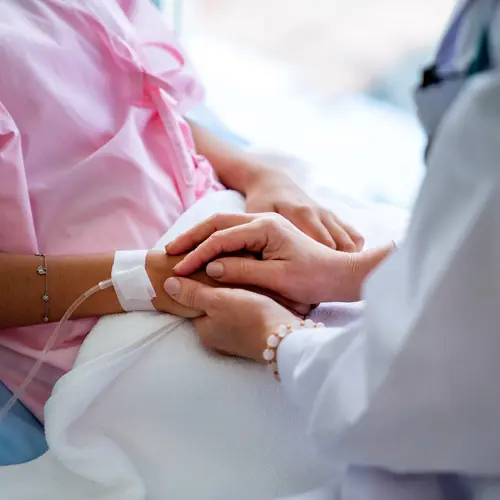New Ways to Detect Diseased Cells Early On

Hide Video Transcript
Video Transcript
ROBIN ROBERTS
No doubt you've heard the expression, "if we had only caught it earlier." But now, those what-ifs are prompting scientists to literally -- are you ready for this? -- sniff out new methods of detecting cancer in its earliest stages, testing the limits of what we can do in The Cutting Edge of Cancer. Believe it or not, these dogs are highly trained canine detectives, helping scientists like Dr. Cindy Otto sniff out cancer as part of a groundbreaking research program --
DR. CINDY OTTO
Bring it! Good job! ROBIN ROBERTS
-- at Penn Vet Working Dog Center. DR. CINDY OTTO
Our dogs are learning the odor that is associated with something about ovarian cancer. It's an odor that's in the blood that the dogs can recognize and identify. ROBIN ROBERTS
How about these dogs? What is this about? DR. MICHAEL SMITH
Yes, so amazing, cancer-sniffing dogs. Cancer cells give off different chemicals than normal cells, what we call volatile organic compounds. Dogs can detect that. We cannot. Just think of the difference if we can get to the point where we're finding all cancers early, the amazing effect that we're going to have on survival from cancer. ROBIN ROBERTS
It all begins with training these pups with treats -- DR. CINDY OTTO
That's very good. ROBIN ROBERTS
-- just the way you might train your own dog to reinforce behavior, except the training these guys are getting, learning to pick out a unique set of odors, could lead to major breakthroughs in cancer detection. DR. CINDY OTTO
We reward them. And they start to associate that good things happen when I smell the smell. And the dogs are amazing because they get it. ROBIN ROBERTS
Do they ever, because the experiment is complex and the dogs have no problem nosing their way through it. This giant wheel has 12 blood samples, some with scents intended to mislead the dogs. And only one is from someone with ovarian cancer. DR. CINDY OTTO
It's a very fun process to watch them because you can see they're working really hard. They have to be very intense because, as I said, it's a drop of blood, and within that drop of blood, some tiny amount of a chemical that's being released. And they can pick it up. ROBIN ROBERTS
And on command, when the dogs find the right sample, they sit. DR. CINDY OTTO
Generally, our dogs are about 90% able to say, "this is cancer and this is not." My goal is to have the dogs work themselves out of a job. I want them to help develop an electronic system that comes close. ROBIN ROBERTS
In other words, an electronic nose. What you're seeing here, these wires, are actually part of a machine that can detect smell. DR. CINDY OTTO: So the electronic sensor is sort of the translation of the dog's nose into something that can be reproduced widely.
DR. CHARLIE JOHNSON: The next step, which we're just beginning to do, is to try to figure out what chemicals coming out of the blood, what smell, the dogs are actually keying in on.
Right, this looks really good.
And the information will come out as an electronic signal that will tell us whether or not a blood sample is from a woman with ovarian cancer.
DR. CINDY OTTO
We think that the role that these dogs play in changing the face of early detection of cancer is huge. We actually don't even limit it to ovarian cancer. Can they help us with other diseases? ROBIN ROBERTS
Dr. Otto is one of many making remarkable progress in early cancer detection, as is Dr. David Wong, who is developing a different method across the country at UCLA, where he is looking closely at saliva. DR. DAVID WONG
But this is the world's largest bio-repository of spit. ROBIN ROBERTS
You got it, using spit to detect traces of lung cancer with a device he created, called EFIRM. Dr. Wong hopes that this device will one day detect all cancers and be widely available in doctor's offices. Put this saliva collector under your tongue please.
DR. DAVID WONG
What we foresee in the near future is when the patient comes in, a drop of saliva could be obtained from the subject and then could be determined whether those mutations exist. And if they exist, treatment can be prescribed right there in the physician's office. ROBIN ROBERTS
From saliva to sniffing canines, these groundbreaking approaches share common goals to provide fast, noninvasive, and cost-effective methods of early detection, and above all, to create a world where we can detect cancer before it's too late. DR. CINDY OTTO
It gives me chills to think about the impact that we can have. And I think we are on to something that is going to break it wide open and really save lives. 